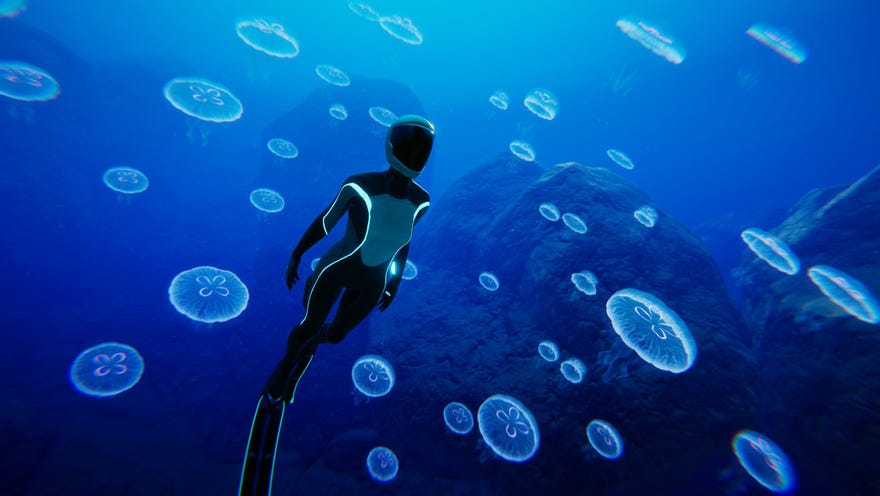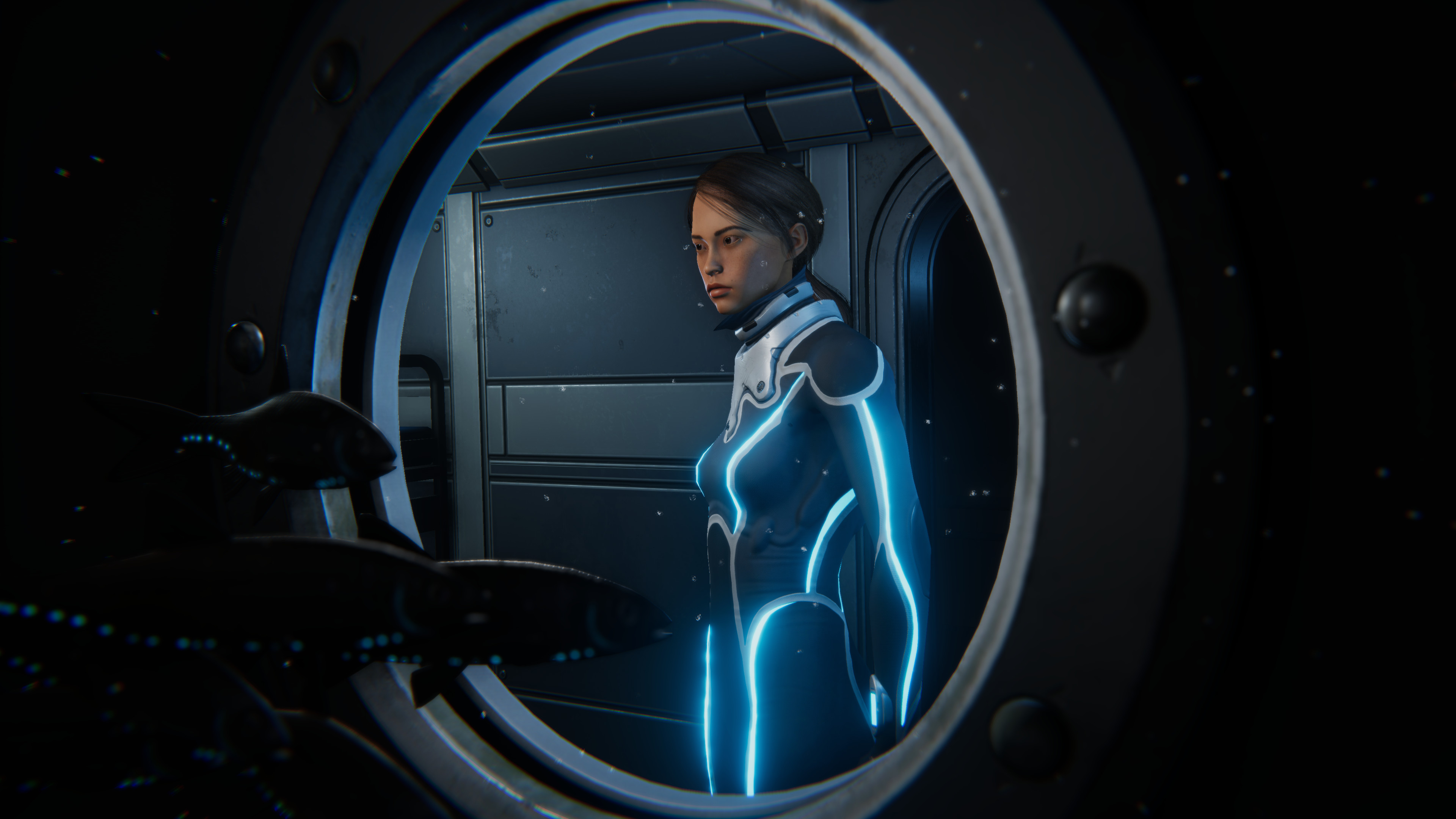Why Beyond Blue is shaping up to be much more than Blue Planet: The Game
Swimming with the fishes
If you've ever been to a big, public gaming show, you'll know a large part of your day is often spent being bombarded by at least fifteen different loudspeakers all vying for you to come and sample the source of their whizz-pop sound effects and booming trailer videos. E-Line Media's booth for ocean explorathon Beyond Blue, however, was like a small oasis of calm when I visited it back at PAX East, if only because the developers had sensibly given everyone headphones so the soothing whines of its whales and sharp clicks of its playful dolphins wouldn't get lost in the surrounding hubbub of the very loud Just Beats and Shapes pod next door.
I'm glad they did, because otherwise I'd have missed a large chunk of what makes Beyond Blue so intriguing. Developed in close partnership with the BBC's Blue Planet II documentary crew, it might not offer quite as romantic a vision of the ocean as, say, the lovely Abzu does, but its natural, semi-photorealistic divers and sea life feel just as wonderful to control and interact with. Beyond that, its emphasis on tracking, cataloguing and getting players to think critically about the state of our own real-life oceans through what sounds like an almost Jurassic World Evolution-style strategy layer suggests E-Line are dropping their anchor much deeper than other ocean explorer games have before.
If the name E-Line doesn't ring any bells, you've probably heard of their previous edu-platforming game, Never Alone, which focused on the Iñupiaq community native to north Alaska. In fact, it was because the BBC's games division loved Never Alone so much that the Beeb even considered making a game to tie in with Blue Planet II at all.
"[The BBC] were fans of our last game, Never Alone, so they called us and 'Hey we're working on this fantastic new documentary series, the sequel to Blue Planet - Blue Planet II - do you guys want to make a game that’s inspired by the events of that?" says E-Line's community and marketing manager Eric Fransen. "So what we've put together is a fictional game, but you'll notice a lot of creatures, themes and even footage from the series will be appearing in the game."
"Winning the BAFTA helped," adds E-Line's VP of marketing Steve Zimmerman, referring to their 2014 win for Best Debut game. "That brought us to their attention. But they've been fantastic partners. It wasn’t just the footage from Blue Planet II [they gave us]. It was a lot of the unused footage as well, plus the research and then access to a lot of the producers and the researchers." Zimmerman says that specific producers of the show, researchers, and the cameramen who got the footage are all going to be part of Beyond Blue's "ocean insights", little video info snippets appearing throughout the game. "It's a partnership, and we want to make sure that what we're representing is as accurate as possible."
That doesn't mean E-Line are going to force you to watch hours of documentary footage, though, as they know all too well from their experience with Never Alone that force-feeding players little educational nuggets isn't particularly effective.
"One of the things we pride ourselves on and try to build into every game we do is a positive social impact in some way, but without beating people over the head with it," says Zimmerman. "The player can make the choice whether they view it or not. It’s something you unlock as if it were an achievement, so if you’re looking for that little bit of extra depth or extra content, it’s there, you can access it and check it out."
"We found it to be extremely effective with Never Alone as an organic way to introduce that," Fransen adds. "We found there were a large number of players went back and watched those documentaries, so we’ve found a formula that worked. I mean, we know more about the surface of Mars than our own ocean. We think it’s pretty darn cool, so there’s a lot to uncover."
Indeed, with comparatively little information to go on when it came to creating the various biomes of Beyond Blue's South China sea, Zimmerman says the team used a mixture of science and imagination to try and work out what your diver protagonist Mirai might end up encountering there.
"By using a specific geographical location, we’re able to look at the different biomes at the different depths, and then make assertations as to what the geography and topography looked like throughout those spaces," he explains. At PAX they were featuring the Atoll, a coral reef with lots of bright colours, but previous demos used Twilight Zone, with less vegetation and less life, or the pitch black Midnight Zone that's lit by bioluminescence. "By using a more targeted geographical area, we could dial in what sea creatures we’d be seeing at each depth of the water column, which would then inform us what would make it into the game. We’re definitely not heading down the Subnautica route, which has a lot of jump scares. It’s not that."
Personally, I'd be quite happy spending the entire game just paddling around the bright, pastel-coloured shoals of the Atoll, which was absolutely brimming with sea life in every direction. Schools of fish were weaving in and out of coral-encrusted sea arches, while up above there were entire pods of dolphins lolloping about in the shimmering sunshine breaking through the waves. One even took a fancy to a sunken branch I found lying on the sea bed, playfully catching it in its teeth when Mirai let it loose in the water. It was a beautiful sight, and easily the equal of many an Abzu vista.
The main objective of my demo was to hunt down a series of underwater beacons and use their built-in telescopes and sensors to locate a handful of data trackers, but you can just as easily spend your time using your helmet's built-in sensors to tag and scan nearby creatures to add them to your ever-expanding database. There's no ticking time bar in the form of an oxygen meter or stamina gauge, for example, and you're pretty much left to your own devices – which is just as well, really, because Mirai's just an absolute joy to flipper up and down between the Atoll's many creviced reefs. Every muscle seemed perfectly tuned to each press and prod of the controller, and if I didn't know any better I'd have sworn blind I was playing Abzu's HD remake.
The dolphins were also a delight to watch from afar as they rolled through the water hooting and clicking at each other, and that's all down to one of E-Line's super talented animators.
"We have an animator that specialises specifically in creature animations that live underwater," says Fransen. "It's his thing, one of his big passions. We’ve aimed for a natural but not photorealistic look, which has given us a little bit of leeway there, but again, access to the footage, extensive research for reference on all the art work has been a big part of that process."
"We’ve also been informed by a lot of the scientists," says Zimmerman. "We’ve got a couple of divers and swimmers on the team. How you float naturally on the water column isn’t actually as stiff as people think it is, for example, and so you have to capture that motion."
It definitely shows, but what I'm most intrigued about is what I didn't see in my demo. It's still not entirely clear what shape it will take yet – Zimmerman and Fransen wouldn't be drawn on exact details – but it sounds as though Beyond Blue will also have a strategic element to it not too dissimilar from the scientific, commercial and conservation triangle in Jurassic World Evolution, taking place on your submarine once you've completed each diving mission.
"On the submarine, that's where you’re retreating to look at the data, making some higher stakes decisions," says Fransen. "It’s your safe place to hop out of the water and talk to your crew and decide what path you’re going to take."
"Some of the challenges and the quests and the decisions that we’re presenting within the game, you have to actually think about how you’d handle this in the real world, " says Zimmerman. "How are your decisions going to impact science and research further down the line?" He explains that one thing they realised from talking to the researchers and scientists is that every scientist or researcher is in it for their own reasons, to a greater or lesser degree. "They might be interested in advocating for the conversation of the environment, or the species that they’re directly working with, or they might just want to advance further knowledge, or they’re looking for medicine."
There's also what they choose to do with the research when they're finished. Do they make it public, give it to corporations, send it to government researchers, look for more funding. "Will we advocate on behalf of opening up whaling grounds, will we advocate on behalf of making sure that the quota for the crab haul in Alaska is a certain amount? So there’s personal decisions that you’ll have to make with your own international team within the game," Zimmerman says, adding that your relationships with your team may change, as their stakes in the game may not be the same as your own.
As I said, it's not yet clear how much of your time will be spent dealing with these decisions, but I'm curious to see E-Line's take on this particular genre, and just how deeply it will affect your underlying actions. Fortunately, it looks like we won't have to wait too long to find out, either, as Beyond Blue is currently due to surface on Steam later this summer.














